Introduction
Halophytes are unique plants that thrive in saline habitats where most other plants cannot survive. Found in coastal marshes, mangrove forests, estuaries, and salt deserts, these plants have developed specialized features to cope with high salt concentrations and waterlogged conditions. Among the most studied halophytes is Avicennia, a mangrove species well known for its salt glands and pneumatophores. Understanding the adaptations of halophytes (Avicennia) is important not only for biology students but also for appreciating their ecological role in protecting coastal ecosystems. This article explores the morphological, anatomical, and physiological adaptations of halophytes, supported with examples and exam-oriented FAQs.
Ecology Notes | Ecology PPTs | Ecology MCQs
Adaptations of Halophytes (Avicennia)
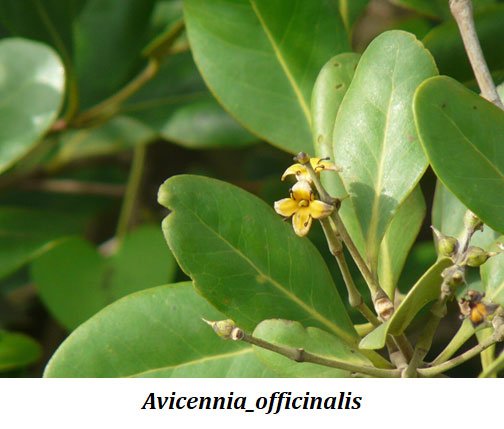
Dinesh Valke from Thane, India, CC BY-SA 2.0, via Wikimedia Commons
What are Halophytes?
Halophytes are plants that can grow and reproduce in environments with high salt concentrations, often exceeding seawater levels. Unlike most plants, they tolerate or actively regulate excess salts through unique mechanisms.
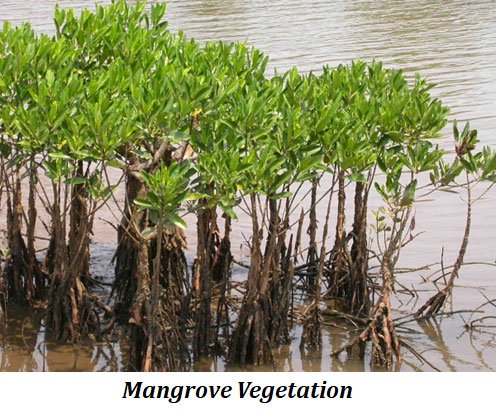
see other version, CC BY-SA 3.0, via Wikimedia Commons
🔹 Halophytes vs Xerophytes
- Halophytes → Adapted to saline soils and tidal habitats; features include salt glands, pneumatophores, and vivipary. Example: Avicennia marina.
- Xerophytes → Adapted to dry/desert conditions; features include spines, thick cuticle, and CAM photosynthesis. Example: Opuntia.
Examples of halophytes: Avicennia, Rhizophora, Salicornia, Suaeda.
Morphological Adaptations of Halophytes
Pneumatophores (Breathing Roots)
- Pneumatophores are negatively geotropic roots that grow vertically upwards from underground root systems.
- They are equipped with lenticels (small pores) that allow gaseous exchange in oxygen-deficient, waterlogged soils.
- This adaptation ensures continuous respiration even under anaerobic conditions.
- Examples: Avicennia, Sonneratia.
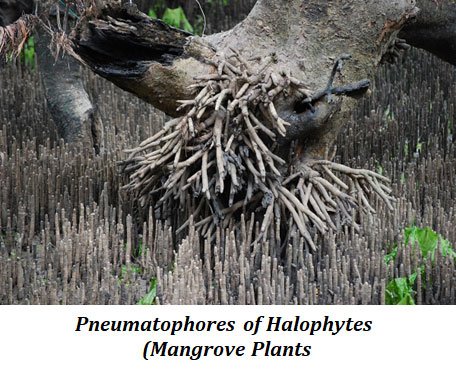
Peripitus, CC BY-SA 3.0, via Wikimedia Commons
Vivipary (Seed Germination on Parent Plant)
- In many mangroves, seeds germinate while still attached to the mother plant.
- This strategy allows seedlings to be well-developed before falling into unstable saline mud.
- It enhances establishment and survival in harsh conditions.
- Examples: Rhizophora, Bruguiera.
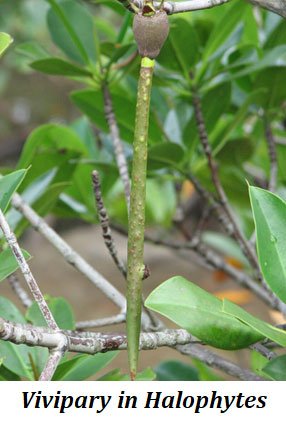
Nutshelf, CC BY-SA 4.0, via Wikimedia Commons
| You may also like NOTES in... | ||
|---|---|---|
| BOTANY | BIOCHEMISTRY | MOL. BIOLOGY |
| ZOOLOGY | MICROBIOLOGY | BIOSTATISTICS |
| ECOLOGY | IMMUNOLOGY | BIOTECHNOLOGY |
| GENETICS | EMBRYOLOGY | PHYSIOLOGY |
| EVOLUTION | BIOPHYSICS | BIOINFORMATICS |
Salt-excreting Glands
- Special glands on the leaves actively secrete excess salts absorbed from saline water.
- Salt appears as crystals on the leaf surface and may be washed off by rain.
- This prevents salt toxicity in tissues.
- Examples: Avicennia marina, Aegiceras.
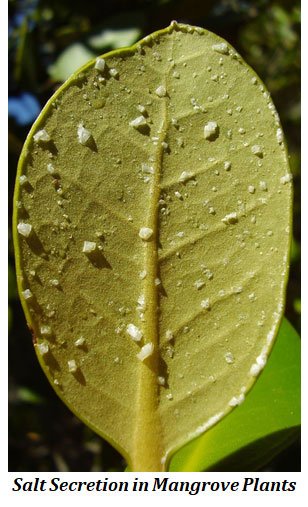
Peripitus, Public domain, via Wikimedia Commons
Succulent and Leathery Leaves
- Leaves are fleshy and thick to store water.
- Succulence dilutes excess salts and prevents plasmolysis.
- A thick cuticle and leathery texture reduce water loss by transpiration.
Stilt and Buttress Roots
- These roots provide strong anchorage in soft, muddy soils.
- They brace the plant against tidal waves and storm currents.
- Stilt roots also absorb nutrients in nutrient-poor conditions.
- Examples: Rhizophora, Heritiera.
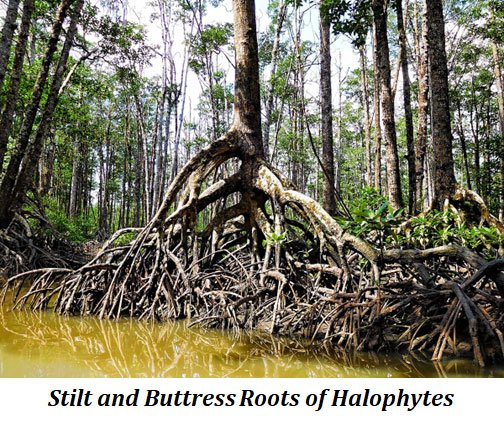
Dan Lundberg, CC BY-SA 2.0, via Wikimedia Commons
Anatomical Adaptations of Halophytes
Aerenchyma in Roots and Stems
- Aerenchyma are tissues with large air spaces.
- They facilitate oxygen diffusion from aerial parts to submerged roots.
- This reduces the harmful effects of anoxic soils.
Water Storage Tissue (Hydrenchyma)
- Leaves often contain parenchymatous tissues specialized for water storage.
- Stored water ensures photosynthesis and other physiological activities continue during osmotic stress.
Highly Lignified Vascular Tissues
- Xylem vessels and fibers are heavily lignified.
- This provides mechanical strength against tidal currents.
- Lignification also prevents tissue collapse under osmotic stress.
- Example: Rhizophora.
Sunken Stomata
- Stomata are located in grooves below the leaf surface.
- This reduces direct exposure to saline winds.
- Helps in minimizing transpiration and conserving water.
- Examples: Avicennia.
Physiological Adaptations in Avicennia
- Salt regulation: Some species exclude salts at the root level, while others excrete excess salts through glands.
- Osmotic balance: Organic solutes like proline and sugars help maintain turgor pressure.
- Photosynthesis: Adapted to withstand high salinity without reducing photosynthetic efficiency.
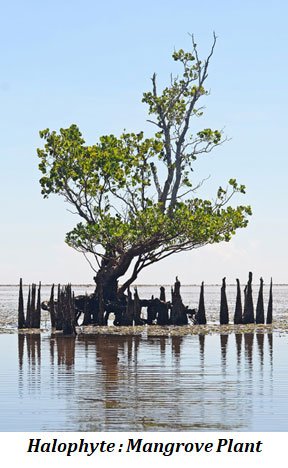
Ariefrahman, CC BY-SA 4.0, via Wikimedia Commons
Ecological Significance of Halophytes
Halophytes like Avicennia are more than survival specialists—they are ecosystem engineers.
- Soil stabilization: Their roots bind loose sediments, preventing erosion.
- Storm protection: They act as natural barriers against cyclones and tsunamis.
- Habitat creation: Provide shelter and breeding grounds for fish, crabs, and birds.
- Biodiversity conservation: Support diverse coastal ecosystems.
FAQs on Halophytes (Exam-Oriented)
Short Answer Questions (2-3 Marks)
- Define halophytes with one example.
- Mention any three morphological adaptations.
- What is vivipary? Give an example.
- State two functions of pneumatophores.
- How do salt glands help survival?
- Write any two functions of succulence.
- Why are stilt roots important?
- Differentiate between xerophytes and halophytes.
- What is the role of aerenchyma?
- Mention two anatomical adaptations to prevent water loss.
Short Essay Questions (5 to 6 Marks)
- Adaptations of pneumatophores with examples.
- Ecological significance of vivipary.
- Structure and function of salt glands.
- Succulence vs hydrenchyma.
- Role of stilt and buttress roots.
- Function of aerenchyma.
- Role of sunken stomata.
- Significance of combining morphological and anatomical features.
- Compare halophytic and xerophytic adaptations.
Essay Questions (10 – 15 Marks)
- Detailed morphological and anatomical adaptations of halophytes.
- Structural and physiological adaptations of Avicennia.
- Ecological significance of halophytes in coastal stability.
Download Answers of these questions in PDF
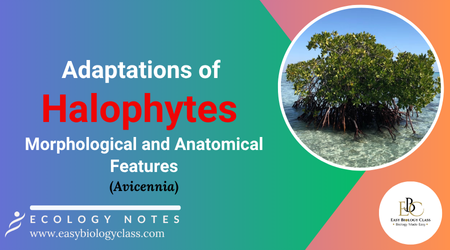
Conclusion
Halophytes, particularly Avicennia, represent some of the most remarkable examples of plant adaptation in nature. With features like pneumatophores, vivipary, salt glands, succulence, and specialized roots, they not only survive but thrive in saline, waterlogged environments. Beyond survival, halophytes play a critical ecological role—stabilizing coastlines, protecting against storms, and supporting biodiversity. Conserving mangrove ecosystems is essential for both environmental sustainability and human well-being.
Download Quick Note PDF: Adaptations of Halophytes
| You may also like... | ||
|---|---|---|
| NOTES | QUESTION BANK | COMPETITIVE EXAMS. |
| PPTs | UNIVERSITY EXAMS | DIFFERENCE BETWEEN.. |
| MCQs | PLUS ONE BIOLOGY | NEWS & JOBS |
| MOCK TESTS | PLUS TWO BIOLOGY | PRACTICAL |
